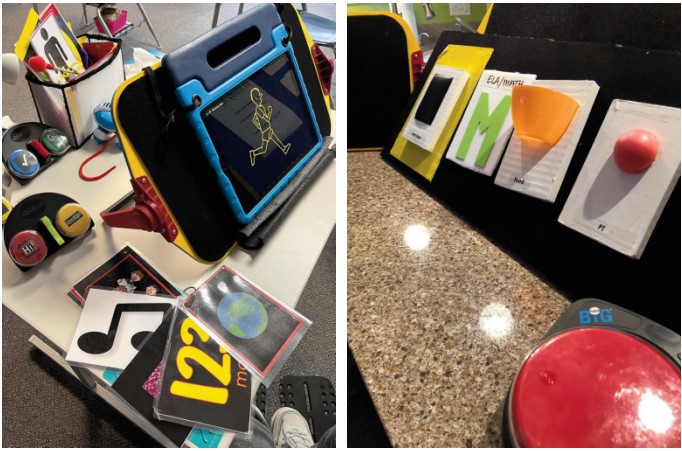WE LEARNED THAT MJ NEEDED TIME TO PROCESS AND WE NEEDED TO BE PATIENT. ALLOWING PROCESSING TIME HAS BEEN A FOCUS FOR US THROUGHOUT OUR JOURNEY.
At about three years old, MJ was introduced to the New York Deaf-Blind Collaborative (NYDBC), which supports students with DeafBlindness, their educational team and family. My husband and I took some training classes, and NYDBC visited my son's school. That visit confirmed that my son has Cortical Visual Impairment (CVI). The short explanation of CVI is that there is a processing disorder between the brain and the eye. Modifications vary depending on what Phase of CVI a person is in. The good news is that CVI can improve with continued modifications. There is no medical treatment for CVI. Some ophthalmologists recognize CVI, but others do not. We found it best to rely on our TVI and NYDBC for support.
We learned about CVI and how this would impact MJ's access to his environment, including communication. Allowing MJ time to process information has been a key in making connections. When MJ is looking at something, especially unfamiliar, he may look at it and then look away multiple times. This is visual latency. Although MJ may really want to look at the object/environment, he needs processing time and that is when he looks away. MJ may also look at something from the corner of his eye, but will not directly look at it until there has been some processing time. Sometimes people have thought MJ doesn't like something, but he does. He just needs to process the visual input. This is a guideline we use for processing time and CVI. One of the biggest misconceptions about CVI is that vision fluctuates from day to day, or is variable. It is not the student's vision that fluctuates, but rather the complexity of the environment and materials presented to the student that fluctuate. Intervention should be geared toward understanding the impact of complexity on visual processing, balancing the complexity on visual processing, balancing the complexity of tasks and the environment, to maximize visual functioning throughout the day. This consideration directly impacts MJ's communication.

CHANNELS OF COMMUNICATION: (Above left) MJ uses multiple communication devices and a visual schedule (above, right) that help with anticipating and planning for his daily activities.
WE HAD TO LEARN THAT MJ NEEDED LESS VISUALLY COMPLEX ITEMS, PREFERRED: COLORS, SOME ITEMS DISTINCTLY OUTLINED, AND CONTRASTED BACKGROUNDS.
A CVI Range was completed to help guide us on what modifications were needed. We began using pre-symbolic communication called 3D tangible symbols. MJ advanced to 2D symbols (pictures) because of proper modifications. We used symbols to create a visual schedule that would help with planning and anticipation for MJ's days. We continued to match the item with the 3D symbol and eventually transitioned to just the image.
We began creating a 2 column communication chart. This was where we would identify body gestures and sounds that may mean something. MJ began tactile communication by touching his body.
He has also learned some signing. Another way we communicate with MJ is through consistent and repetitive activities. On school mornings, we put MJ's long socks that he wears with his braces on him to let him know he is going to school. We are sure to do it only when going to school. We have found positioning to be a great communication avenue for MJ, to anticipate what is happening. We always try to use MJ's wheelchair as his safe space. This is one of many best practices for MJ's communication. When we go to the doctor, we transfer MJ out of his wheelchair, so he knows he will be examined. He transfers back to the wheelchair to know he is finished. Often, he claps his hands and becomes excited. We try to follow consistent position schedules at school and home, to help MJ feel grounded. I can't imagine going through my day not knowing what will happen next, and that any activity has no beginning or end. Developing a consistent routine helps MJ with anticipation and not have a high level of stress about what is going on. This allows him to focus on his activities. We always make sure to let MJ know we are in his presence, and ask others to do so. We have specific steps to entering MJ's personal space and use consistent tactile input (i.e., touching the same place on his arm). Creating a best practices list specific to respectful communication for MJ has been very helpful.
MJ is a multi-modal communicator. This means we use multiple forms of communication to include body posture, facial expression, gesture, communication devices, vocalizations, picture symbols, and seating positions. As noted, he does not stay in his wheelchair, so we have had to plan for him to access his modes of communication in multiple settings. Our goal is to move all his communication to his iPad. However, we want to leave every mode available for MJ to communicate. Currently, MJ uses his iPad to play apps that are CVI-friendly. MJ continues to improve his expressive communication by vocalizing, shaking his head, tapping his shoulder, reaching, making choices between symbols, and looking. The challenging part is when MJ tells us he needs, feels, or wants something, and we cannot figure it out. It is especially difficult when he doesn't seem to be feeling well.